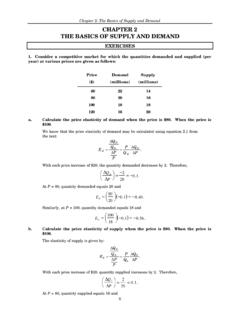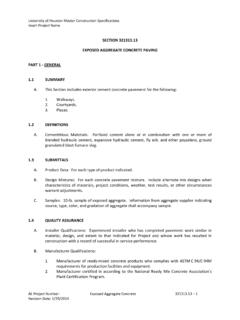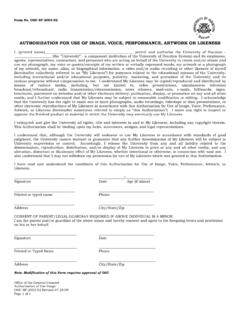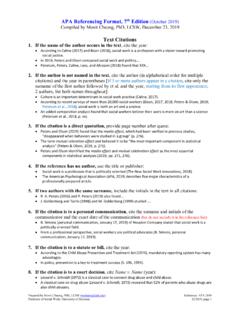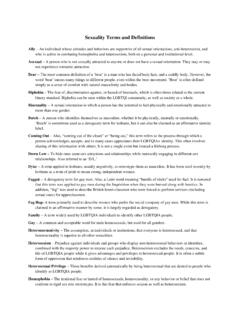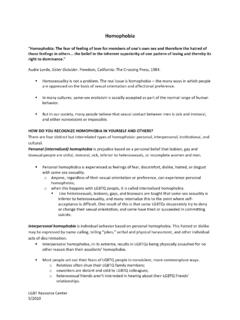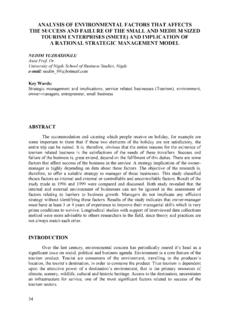Transcription of CHAPTER 13 GAME THEORY AND COMPETITIVE STRATEGY
1 CHAPTER 13: Game THEORY and COMPETITIVE Equilibrium 186 CHAPTER 13 GAME THEORY AND COMPETITIVE STRATEGY EXERCISES 3. Two computer firms, A and B, are planning to market network systems for office information management. Each firm can develop either a fast, high-quality system (H), or a slower, low-quality system (L). Market research indicates that the resulting profits to each firm for the alternative strategies are given by the following payoff matrix: Firm B H L H 30, 30 50, 35 Firm A L 40, 60 20, 20 a. If both firms make their decisions at the same time and follow maximin (low-risk) strategies, what will the outcome be?
2 With a maximin STRATEGY , a firm determines the worst outcome for each option, then chooses the option that maximizes the payoff among the worst outcomes. If Firm A chooses H, the worst payoff would occur if Firm B chooses H: A s payoff would be 30. If Firm A chooses L, the worst payoff would occur if Firm B chooses L: A s payoff would be 20. With a maximin STRATEGY , A therefore chooses H. If Firm B chooses L, the worst payoff would occur if Firm A chooses L: the payoff would be 20. If Firm B chooses H, the worst payoff, 30, would occur if Firm A chooses L. With a maximin STRATEGY , B therefore chooses H.
3 So under maximin, both A and B produce a high-quality system. b. Suppose both firms try to maximize profits, but Firm A has a head start in planning, and can commit first. Now what will the outcome be? What will the outcome be if Firm B has a head start in planning and can commit first? If Firm A can commit first, it will choose H, because it knows that Firm B will rationally choose L, since L gives a higher payoff to B (35 vs. 30). This gives Firm A a payoff of 50. If Firm B can commit first, it will choose H, because it knows that Firm A will rationally choose L, since L gives a higher payoff to A (40 vs.)
4 30). This gives Firm B a payoff of 60. 4. Two firms are in the chocolate market. Each can choose to go for the high end of the market (high quality) or the low end (low quality). Resulting profits are given by the following payoff matrix: Firm 2 Low High Low -20, -30 900, 600 Firm 1 High 100, 800 50, 50 a. What outcomes, if any, are Nash equilibria? If Firm 2 chooses Low and Firm 1 chooses High, neither will have an incentive to change (100 > -20 for Firm 1 and 800 > 50 for Firm 2). If Firm 2 chooses High and CHAPTER 13: Game THEORY and COMPETITIVE Equilibrium 187 Firm 1 chooses Low, neither will have an incentive to change (900 > 50 for Firm 1 and 600 > -30 for Firm 2).
5 Both outcomes are Nash equilibria. b. If the manager of each firm is conservative and each follows a maximin STRATEGY , what will be the outcome? If Firm 1 chooses Low, its worst payoff, -20, would occur if Firm 2 chooses Low. If Firm 1 chooses High, its worst payoff, 50, would occur if Firm 2 chooses High. Therefore, with a conservative maximin STRATEGY , Firm 1 chooses High. Similarly, if Firm 2 chooses Low, its worst payoff, -30, would occur if Firm 1 chooses Low. If Firm 2 chooses High, its worst payoff, 50, would occur if Firm 1 chooses High. Therefore, with a maximin STRATEGY , Firm 2 chooses High.
6 Thus, both firms choose High, yielding a payoff of 50 for both. c. What is the cooperative outcome? The cooperative outcome would maximize joint payoffs. This would occur if Firm 1 goes for the low end of the market and Firm 2 goes for the high end of the market. The joint payoff is 1,500 (Firm 1 gets 900 and Firm 2 gets 600). d. Which firm benefits most from the cooperative outcome? How much would that firm need to offer the other to persuade it to collude? Firm 1 benefits most from cooperation. The difference between its best payoff under cooperation and the next best payoff is 900 - 100 = 800. To persuade Firm 2 to choose Firm 1 s best option, Firm 1 must offer at least the difference between Firm 2 s payoff under cooperation, 600, and its best payoff, 800, , 200.
7 However, Firm 2 realizes that Firm 1 benefits much more from cooperation and should try to extract as much as it can from Firm 1 (up to 800). 5. Two major networks are competing for viewer ratings in the 8:00-9:00 and 9:00-10:00 slots on a given weeknight. Each has two shows to fill this time period and is juggling its lineup. Each can choose to put its bigger show first or to place it second in the 9:00-10:00 slot. The combination of decisions leads to the following ratings points results: Network 2 First Second First 18, 18 23, 20 Network 1 Second 4, 23 16, 16 a. Find the Nash equilibria for this game, assuming that both networks make their decisions at the same time.
8 A Nash equilibrium exists when neither party has an incentive to alter its STRATEGY , taking the other s STRATEGY as given. By inspecting each of the four combinations, we find that (First, Second) is the only Nash equilibrium, yielding a payoff of (23, 20). There is no incentive for either party to change from this outcome. b. If each network is risk averse and uses a maximin STRATEGY , what will be the resulting equilibrium? This conservative STRATEGY of minimizing the maximum loss focuses on limiting the extent of the worst possible outcome, to the exclusion of possible good outcomes.
9 If Network 1 plays First, the worst payoff is 18. If Network 1 plays Second, the worst payoff is 4. Under maximin, Network 1 plays First. (Here, playing First is a dominant STRATEGY .) If Network 2 plays First, the worst payoff is 18. If Network 2 plays Second, the worst payoff is 16. Under maximin, Network 2 plays First. The maximin equilibrium is (First, First) with a payoff of (18,18). CHAPTER 13: Game THEORY and COMPETITIVE Equilibrium 188 c. What will be the equilibrium if Network 1 can makes its selection first? If Network 2 goes first? If Network 1 plays First, Network 2 will play Second, yielding 23 for Network 1.
10 If Network 1 plays Second, Network 2 will play First, yielding 4 for Network 1. Therefore, if it has the first move, Network 1 will play First, and the resulting equilibrium will be (First, Second). If Network 2 plays First, Network 1 will play First, yielding 18 for Network 2. If Network 2 plays Second, Network 1 will play First, yielding 20 for Network 2. If it has the first move, Network 2 will play Second, and the equilibrium will again be (First, Second). d. Suppose the network managers meet to coordinate schedules, and Network 1 promises to schedule its big show first.
